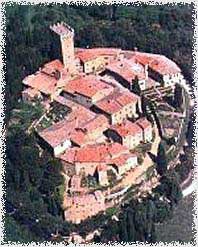Gargonza Castle
The little walled suburb of Gargonza rises around on a hill dominant the Valdichiana (Chiana valley) half road between Arezzo and Siena in the common of Monte S.Savino only 11 kilometers far from the motorway A1 exit 'Monte S.Savino'.
The Gargonza Castle, splendid testimony of Tuscan fortified agricultural suburb, with its tower, the considerable rests of its walls, a gate of the 13th century, its Roman Church of the 14th century endowed with a bell tower with mullioned windows, its civil medieval buildings leaned out on its narrow alleys, is situated on a hill dominant the Chiana Valley. Today it is one of the better preserved strengthened complex of the whole aretine territory .
|
In the orbit of Arezzo as fief of the counts Ubertini, due to its strategic importance for the position between the Chiana Valley and the Senese territory, in the Middle Age the castle was object of disputes between Guelphs and Ghibellines, as after almost all the small fortress of the zone. In its long history the most important event is perhaps that of the presence in 1304 between the walls of the castle of the great poet Dante Alighieri, White Guelph, who participated at the reunion between the Ghibellines escaped from Florence and the Aretinis. In 1307 the castle suffered a hard attack and a siege from the Florentine armies but, thanks to the diffusion of the false news of the imminent arrival in Florence of the army of the cardinal Orsini, Gargonza succeeded to avoiding capitulation. In the 1381 the castle was sold to the Senese Republic but already four years after it was reoccupied by the Florentines. The inhabitants of the suburb were not certain satisfied of the Florence dominion and in 1433 rose a revolt. This caused the armed reaction of the Florentine that leveled the suburb to the ground leaving only the keep standing, the embattled tower that still today dominate the inhabited area.
In 1546 the castle passed to the Lotteringhi della Stufa family and at the end of the '600 at the the marquises Corsi, ancestors of the actual owners, that transformed the castle in an agricultural estate. In the 18th century the Granducal political of reclamation of the Chiana Valley was also extended to the hilly zones of the farm, and it is interesting to observe as the actual territory maintains the imprint of this important intervention.
The agricultural period stopped immediately after the last conflict, with the end of the métayage, and this causing a general exodus from the country. Gargonza remained nearly uninhabited and in downfall. Around the seventies years of this century the count Roberto Guicciardini Corsi Salviati undertook a work of conservative restoration with the purpose to maintain the genuine architectural values of the ancient medieval suburb. Gargonza is today an important agrituristical center and belongs to the association Live the History.
| Back to Homepage |
| Back to Castles Index |
